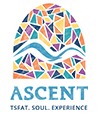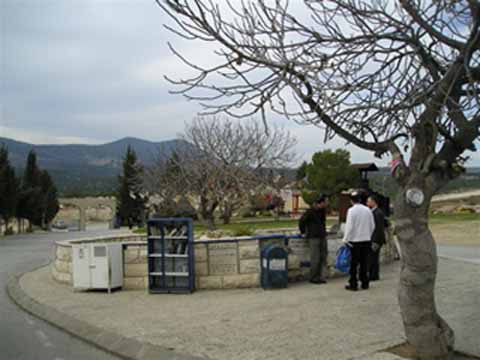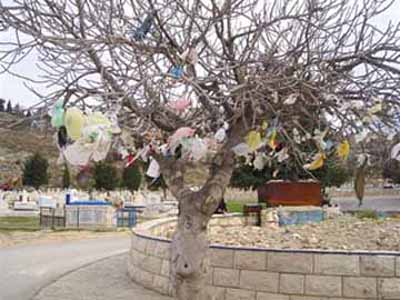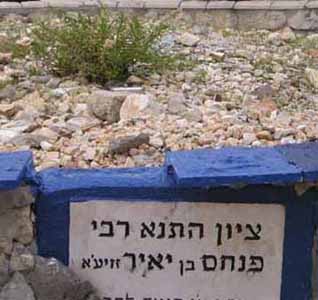by Chana Katz
The resting place of Rabbi Pinchas Ben Yair, the father-in-law** of Rabbi Shimon bar Yochai, lays at the entrance of Tsfat’s new cemetery. Yet, it outdates by many centuries, not only the burial sites in the new cemetery, but even those of the luminaries from the “Golden Era” whose well-visited gravesites hover up the side of the mountain in the famous ancient cemetery.
That is because we are going back in time almost 2000 years, when the daughter of the pure, holy soul, Rabbi Pinchas, wed Rabbi Shimon Bar Yochai, author of the deepest kabbalistic insights into the Torah, the Zohar. Rabbi Bar Yochai was buried directly across the valley at the foot of Mount Meron.
It’s as though time has sharpened, and not dulled, the significance of those inner dimensions of Torah, becoming a tribute to just how far they’ve spread. On any given day, a number of visitors to the site of Rabbi Pinchas can be seen circling the circular stone wall seven times. Youths, elders, visitors of all sorts, they all seem to know that circling the site seven times – often reciting prayers or Tehillim, especially chapter 91, — is a known “segulah” or channel, to receive a blessing.
And the more we learn about Rabbi Pinchas, the more we can see the merits with which he earned this special role of helping to direct the heartfelt prayer of even a simple Jew to the right address in the loftiest of heavenly chambers.
It is said in the Talmud (Chulin 7a) that Rabbi Pinchas was extremely careful never to partake from someone else’s meal and that he refused to accept support from others.
But it was not only the latter deeds alone which merited a river to split for Rabbi Pinchas. In fact, while the sea split one time for Moshe Rabbeinu, it is said that for Rabbi Pinchas, the river Ginnai, parted three times upon his command, including once even for a gentile servant.
It’s written in the Yerushalmi Talmud that Rabbi Pinchas’s students gathered the courage to ask their teacher in what merit this occurred. That is, besides the merit Rabbi Pinchas had earned because he was on the way to performing the mitzvah of redeeming a Jewish captive at the time.
His students were curious to know if this miracle could also happen for them. And this is what Rabbi Pinchas told them: “It would work only if they were sure they never hurt another person’s feelings or harmed a person in any other way during their entire lives!”
If Rabbi Pinchas earned such a flawless posture with his fellow, it might be interesting to know that even Rabbi Pinchas’s animals were no mere four-legged creatures.
There was once a famous conversation between Torah sages who were comparing the various generations. While the earliest generations of sages were likened to angels, later generations merited merely the appellation of humans, while still later generations by comparison were likened to donkeys – “and not even the donkeys of Rabbi Pinchas ben Yair, which were credited with instinctively knowing not to eat from food that wasn’t properly tithed, or separated according to Jewish law.
Rabbi Pinchas taught us that any problem we face in regards to what seem like personal difficulties, is all a result from not performing the mitzvoth properly.
* * *
Although Rabbi Pinchas’s era marked the sixth and last generation of Torah scholars known as Tannaim, from 120 CE to 200 CE, a famous story is told of how his essence appeared to the Holy Ari, Rabbi Issac Luria, centuries later in Tsfat. . .
This fascinating story tells how the Ari was sitting one day with his leading disciple, Rabbi Chaim Vital, when he suddenly jumped to his feet as a young man entered his study room. Rav Vital couldn’t understand this great show of honor so formidably given by the great Ari to this young and relatively simple Jew. To which the Ari responded, that he was welcoming the spirit of Rabbi Pinchas which had hovered over the lad’s head. (To read the complete story and see the merit the young lad had for this great occurrence to happen, see Ascent Chassidic story #197 by Yrachmiel Tilles, “The Holy Ari Honors a Younger Man”).
If that story arouses your curiosity to delve further into the deeper discourses of Rabbi Pinchas, one can find a true gem from the mystical fountains on Ascent’s Kabbalah-On-Line site under Parsha Balak/Zohar in a piece by Simcha Treister called “The Fountain of Rabbi Pinchas.”
Although Rabbi Pinchas reached all these lofty levels, he actually provided a ladder for the rest of us to embark upon our own journey, by outlining in a famous “Beraisa” the steps which lead upwards…
Everything has a start, and according to Rabbi Pinchas, the very first step is the study of Torah, which he says will lead one to watchfulness. The watchfulness in turn leads one to an energetic performance of the commandments, which will lead one to a certain level of spiritual purity. . .and further.
And from these levels, things around us start to fall into place, such as that the next time one reads the famous Chassidic work by the Lubavitcher Rebbe, HaYom Yom, he will come across a reference on the seventeenth of the Hebrew month of Shvat.
In this entry, we receive a glimpse into the mystical meanings not only of the splitting of the Sea of Reeds for Moshe, or the parting of the River Gannai thrice for Rabbi Pinchas. We may also gain insight into modern events such as the abnormal action of the Tsunami waves which recently devastated many countries.
For the Rebbe teaches us that it is the will of the Creator for Creation to go against nature when it comes to a righteous soul. For even the seemingly unwieldy realm of nature is but a servant to the will of the Creator and those, such as Rabbi Pinchas, who serve and attach themselves to G-d.
With just these few insights into Rabbi Pinchas, we can surely appreciate why visitors still flock to his resting place at the very bottom of the mountain of Tsfat. One can get there either by traveling all the way down the mountain by foot from the top of the ancient cemetery. This way, one can make a stop at the Holy Ari and all those who helped bring down the teachings of the Zohar to more earthly realms.
Or one can simply drive in a circle around Tsfat to the bottom of the mountain and pass through the entrance to the city’s modern cemetery, where two scarf-laden fig trees and a circular stone monument welcome you to Rabbi Pinchas ben Yair and allude to the days when, as the name Yair implies in future tense, “he will shine.”
Is that referring to the visitor? To Rabbi Pinchas? Perhaps both, or perhaps the collective face of the Jewish People with the imminent – may it be immediate – revelations of the final and complete redemption.
Compiled and adapted by Chana Katz, a former South Florida journalist,who has lived in Tsfat for over a decade. Her articles on life in Israel have reached publications throughout the world.
Editor’s note:
**Although the Talmud refers once (Shabbat 33b) to Rabbi Pinchas as the son-in-law of Rabbi Shimon, the Zohar is clear that he was his father-in-law.



